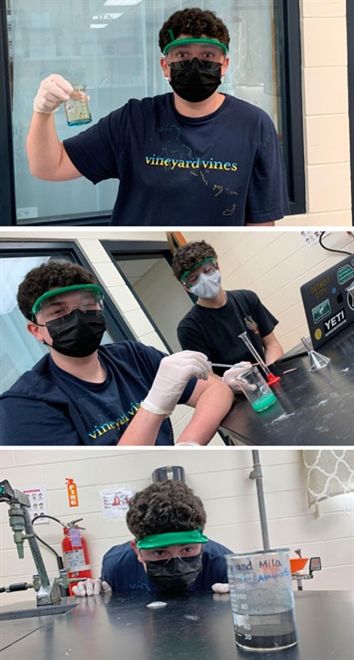

Observing the Copper Cycle
Source/Author: Daniel Burkett, US Science Teacher
April 29, 2021
In Honors Chemistry, students have spent the last couple of weeks learning about redox reactions. In a redox reaction, one reactant is oxidized, meaning it loses electrons; while another reactant is reduced, meaning it gains electrons.
Honors Chemistry students applied their knowledge of acid-base reactions, precipitation reactions, and redox reactions, to observe the copper cycle. Copper commonly exists in several oxidation states, each with a distinct, characteristic color. By observing the color of generated compounds, students were able to determine the various oxidation states of copper throughout this lab.
Pictured:
First students added nitric acid to solid copper, causing copper to be oxidized from the 0 to the +2 oxidation state.
Next they added sodium hydroxide to form solid copper (II) hydroxide, which is a blue solid due to copper's existence in the +2 oxidation state.
Students were able to observe the conversion of copper (II) hydroxide to copper (II) oxide, the black solid at the bottom of the beaker, after heating their reaction mixtures.
Honors Chemistry students applied their knowledge of acid-base reactions, precipitation reactions, and redox reactions, to observe the copper cycle. Copper commonly exists in several oxidation states, each with a distinct, characteristic color. By observing the color of generated compounds, students were able to determine the various oxidation states of copper throughout this lab.
Pictured:
First students added nitric acid to solid copper, causing copper to be oxidized from the 0 to the +2 oxidation state.
Next they added sodium hydroxide to form solid copper (II) hydroxide, which is a blue solid due to copper's existence in the +2 oxidation state.
Students were able to observe the conversion of copper (II) hydroxide to copper (II) oxide, the black solid at the bottom of the beaker, after heating their reaction mixtures.
























